Photo of indivdual bastillas awaiting a dusting of powdered sugar and cinnamon.
Many times I make Bastilla for Sukkot dinner parties since the presentation is so dramatic. Recently I made the filling layers and decided to mix up all the layers and fill individual triangle shaped bastillas. This small individual version makes a great appetizer or starter at parties. It is a wonderful buffet item.
Serves 15 to 25
12 boneless skinless chicken thighs
Salt and Pepper to taste
1 teaspoon Raz al Hanut spice
Water
2 tablespoons olive oil
1 large onion, small dice
1 1/ 2 cups fresh parsley, washed, dried, and chopped
1 1/ 2cups fresh cilantro, washed, dried, and chopped
Sea salt
Freshly ground pepper
1 inch fresh ginger root, grated
1 1/2 cups slivered almonds
1/3 cup sugar
1 tablespoon cinnamon
6 extra large eggs
1 1/ 2 cups chicken broth
1/2 cup olive oil
1 long package fillo dough
Powdered sugar
Sprinkle of cinnamon
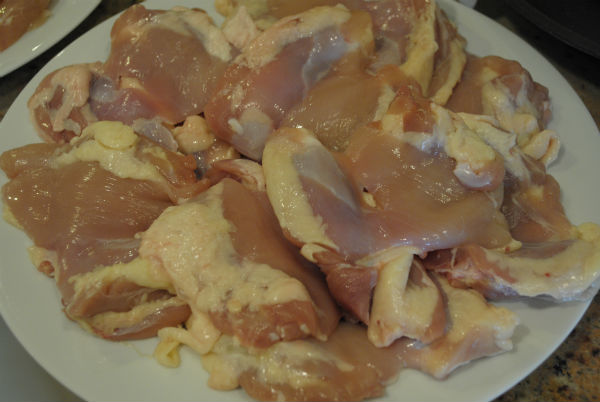 Trim chicken thighs of any excess fat and small bones. Set chicken in a 12 inch skillet with a tight fitting lid and season with salt, pepper and Raz Al Hanut. Raz Al Hanut is a Middle Eastern spice blend available in Middle Eastern markets or by mail-order. Add water to just cover chicken. Place lid on skillet and bring thighs to a boil over medium high heat, turn heat off and let chicken sit undisturbed until cool.
Trim chicken thighs of any excess fat and small bones. Set chicken in a 12 inch skillet with a tight fitting lid and season with salt, pepper and Raz Al Hanut. Raz Al Hanut is a Middle Eastern spice blend available in Middle Eastern markets or by mail-order. Add water to just cover chicken. Place lid on skillet and bring thighs to a boil over medium high heat, turn heat off and let chicken sit undisturbed until cool.
Heat a 12 inch saute′ pan over medium high heat. When saute′ pan is hot, add olive oil and then, onions. Reduce heat to medium. Season onions with salt, pepper and grated ginger. When onions are translucent, add parsley and cilantro. Stir for a few moments, then turn off heat, and let vegetables cool.
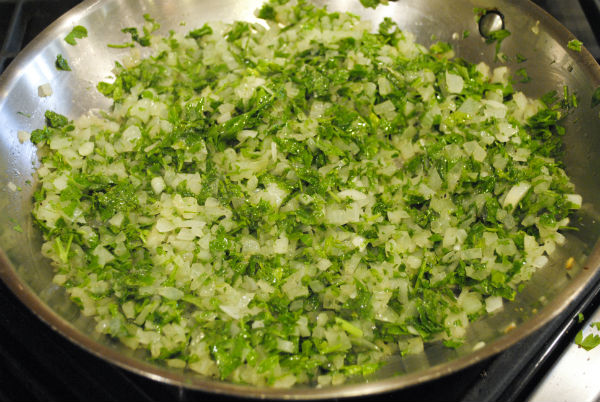 Heat oven to 350° F. Spread slivered (the long spiked pieces) almonds on a rimmed baking sheet, and roast until lightly colored and flavorful, about 5 to7 minutes. Measure cinnamon and sugar into a shallow bowl, then mix hot roasted almonds with sugar and cinnamon. Set aside.
Heat oven to 350° F. Spread slivered (the long spiked pieces) almonds on a rimmed baking sheet, and roast until lightly colored and flavorful, about 5 to7 minutes. Measure cinnamon and sugar into a shallow bowl, then mix hot roasted almonds with sugar and cinnamon. Set aside.
Reserve poaching liquid and remove cooled chicken thighs from poaching liquid, shred and set aside in a large bowl. Place about 1 cup of chicken poaching liquid in a sauté pan and bring to a boil. Crack eggs into a medium bowl and beat well. Add eggs to stock, and gently scramble. Remove from heat when cooked. Eggs will absorb most of the broth. All of these filling parts may be prepared a day ahead of time.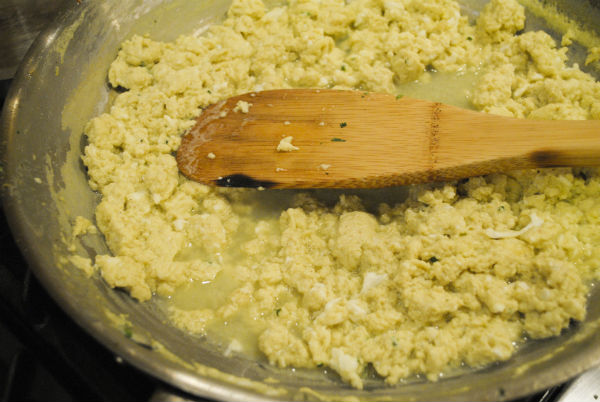
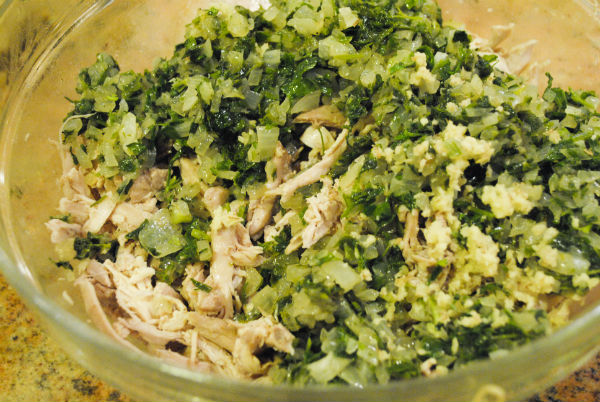 Heat oven to 350º F. Assemble all prepared ingredients, shredded chicken, toasted almonds, sautéed onions and herbs, and scrambled eggs. Combine ingredients in large bowl. Take fillo package out of refrigerator. Pour ½ cup oil into a small bowl or pitcher and prepare a pastry brush (I prefer silicon).
Heat oven to 350º F. Assemble all prepared ingredients, shredded chicken, toasted almonds, sautéed onions and herbs, and scrambled eggs. Combine ingredients in large bowl. Take fillo package out of refrigerator. Pour ½ cup oil into a small bowl or pitcher and prepare a pastry brush (I prefer silicon).
Try to find fresh fillo from a store with high turnover, old or frozen fillo can get very crumbly or layers can stick together.
Unroll fillo dough onto a work surface. Using a very sharp large knife, slice fillo into vertical 2 to 3 inch wide columns all of the way through. Place a piece of plastic wrap covering all but one column to prevent fillo from drying out while you work.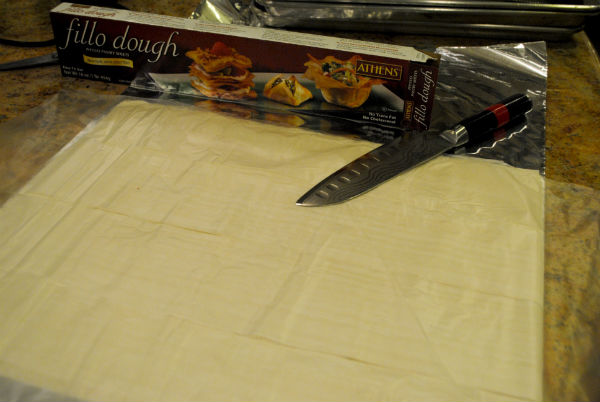
Brush a little oil down the length of fillo column. Place 1 to 2 tablespoons of filing at the bottom and fold up two sheets of fillo going from side to side to create a tight triangle. 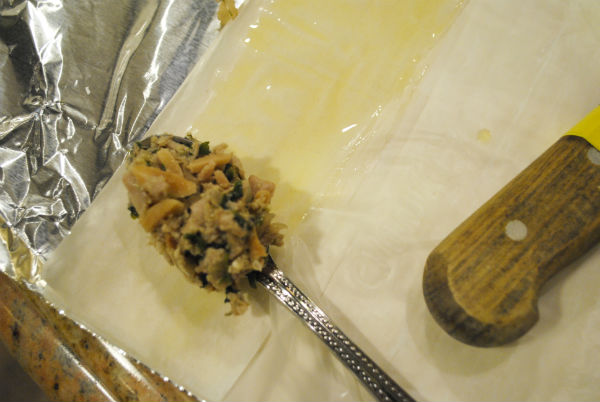
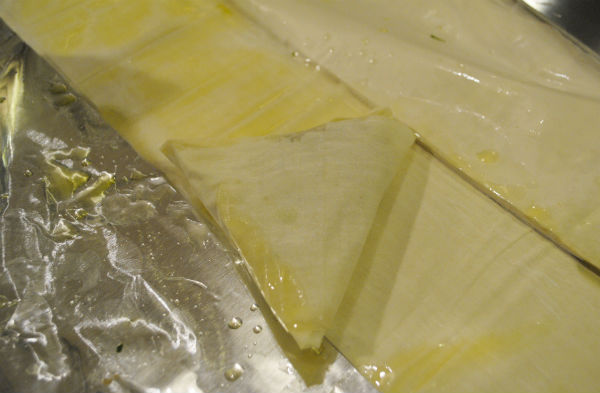 Lightly brush top of completed triangle with oil and place on a parchment of silpat line cookie sheet for baking. Repeat brushing and oiling every two layers (sheets) of dough. When the first column is used up roll the plastic wrap back enough to expose next column.
Lightly brush top of completed triangle with oil and place on a parchment of silpat line cookie sheet for baking. Repeat brushing and oiling every two layers (sheets) of dough. When the first column is used up roll the plastic wrap back enough to expose next column.
 Heat oven to 350°F. Bake individual bastilla triangles until golden and crisp. Serve dusted with powdered sugar and cinnamon.
Heat oven to 350°F. Bake individual bastilla triangles until golden and crisp. Serve dusted with powdered sugar and cinnamon.
If you are thinking that real Moroccan bastilla is made with butter, you are probably right. This is my kosher version and since I don’t have access to fresh pigeon, chicken thighs seemed a good substitute.
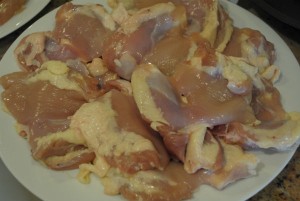
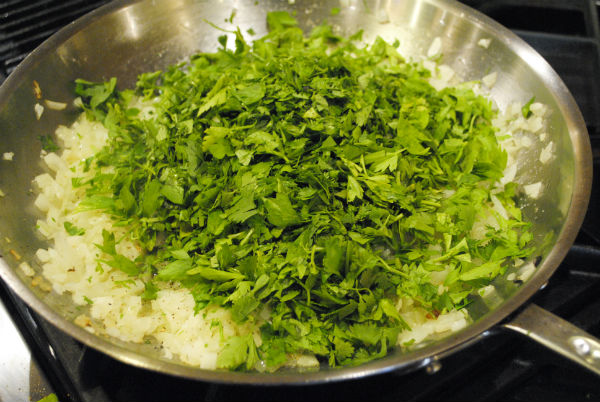


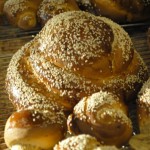
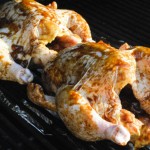
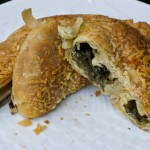

Shalom!
Just a couple of comments — for the interested souls amongst us…
The name “BASTILLA” (BASTYA) is the corruption of the Spanish word “PASTILLA” – (Sepharadi Jews say PASTEL)
Arabic language has no “P” or “V” sound in it. The Arabs, and Arab speaking people, have a problem pronouncing these sounds, hence BASTILLA !
It is said that the dish is Andalusian in origin — and some say it was brought to Morocco by the SEPHARDI JEWS in 1492 …. not verified though. The Moors were in control of The Andalusia for a long time so they may have transported it themselves…
The Moroccan Jews mostly prepare the individual pastillas (pasteles) while the Moslems are known to prepare the elaborate, single pie.
Hi Ehood, thanks for your educational comments. I love to learn the derivation of words. My family speaks many languages and it is always fascinating to trace the origin of our food names be it Ladino or Turkish, Greek or Arabic.
Shalom
I know I commented on this before – but I will do it again.. 🙂
Although “Bastilla” is considered a National Moroccan dish , it is actually of a Spanish origin, and some say it was brought to Morocco by the Sephardi (Spanish) Jews who were expelled from Spain in 1492… Of course the Moors had control of some parts of Spain and may have acquired the dish then…
However, the Arab speaking people have hard time pronouncing the letter “P” and they convert it to “B” – hence the Spanish pastry known as “PASTILLA” (or Sephardi “PASTEL”) has turned into “BASTIYA” in Arabic – but it is of Spanish origin, most likely from Andalusia, and is very prolific with Sephardi Jews around the world – not only Moroccan Arabs …